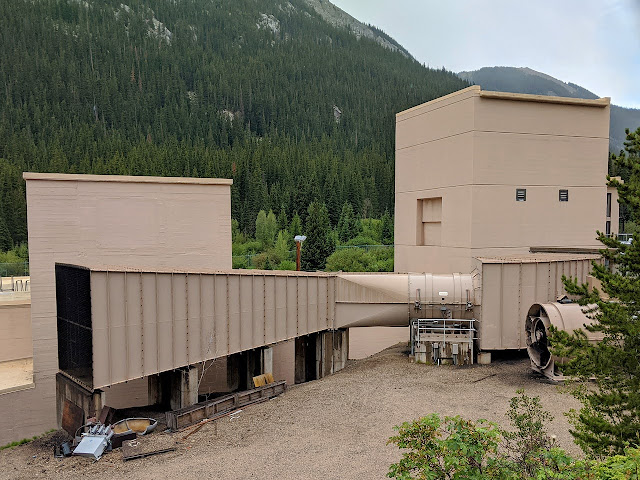The Continental Divide sounds like an intimidating barrier to transcontinental travel, however on some rail lines such as the Southern Pacific's Sunset route the crossing is so sedate that it's not even marked. The Great Northern offers a bit more drama, but was still able to get over the top out in the open at an altitude not much higher than Denver. Colorado however is where the Continental Divide in the form of the Rocky Mountains lives up to the stereotype, creating a massive barrier to east-west travel. While most of the Brand Name railroads built their routes to the north or the south, the Denver, Rio Grande and Western decided to go through the Rockies, not around them and this ultimately took the form of two distinct route. The first ran northwest from Pueblo to the headwaters of the Colorado river over the Tennessee Pass. Unfortunately this meant a 180 mile detour for trains trying to get west from Denver so in 1922 the State government funded a project to tunnel through the Rockies on a more direct route. On my summer 2020 trip out to Denver I visited both of these crossings and you can find the complete set of photos here ( mirror ).
The Moffat Tunnel was built between 1923 and 1928 and runs 6.2 miles underground between a point west of Tolland, CO and the resort community of Winter Park. Due to the length of the tunnel forced ventilation is a requirement, even with comparatively less polluting diesel locomotives. As the comparatively populated Winter Park would object to a constant haze of locomotive exhaust, the fan plant was located on the east side of the mountain seven miles down a dirt road from the nearest state highway.
Unlike the East, large portions of Colorado is public land and therefore the East Portal is a popular trailhead with ample parking, day or night.
The Moffat Tunnel route had actually been first cut by the Denver and Salt Lake Railway, that used an extreme switchback route over the Rollins Pass that ultimately proved unsustainable. This still eased the way for the Moffat Tunnel project that just had to bypass the bit over the Rolls Pass. Today some of the cabins used by the tunnel work crews are still standing and were recently made a state historic landmark.
The original tunnel headhouse consisted of two parts, a pressure door and two large squirrel cage blowers with the gatehouse structure supporting the door and the two boxy towers behind it the blowers. The door would prevent blower air from just rushing in/out the eastern end.
In 1988 the Rio Grande purchased the Southern Pacific with the resulting combination being purchased by Union Pacific in 1996, who operates the tunnel to this day. With the UP's original main line through Wyoming to Ogden, UT offering lower grades and more capacity, the former DRGW route now sees a much reduced amount of traffic with most road freights terminating in Grand Junction, CO leaving Amtrak as the primary user of the line in its original purpose as a shortcut to Salt Lake City and beyond.
The Moffat Tunnel itself was built by the public improvement district and leased to the railroad. Bronze plaques at the east portal attest to the principles involved.
The original fan plant was upgraded to modern standards some time in the 1980's with an entirely new plant built directly behind the first. A new door system was installed and the squirrel cage blowers were replaced by axial turbine units. To avoid polluting Winter Park the fans suck air towards the east end with large exhaust horns attached to the comparatively small electrically driven fans. There are two primary fans located on either side of the tunnel extension.
As giant fans are long lead items, a spare fan motor is on site in case of a failure.
A third fan is available to blow air from the east in the face of slow moving eastbound trains that might become bound in their own exhaust plume. Line speed is 40mph compared with 25mph in the similarly operated Cascade tunnel.
Direct drive diesel backups are provided for each fan.
A 10 foot wide pilot tunnel used in construction of the main bore was repurposed into a pipe to transport water from the Colorado River headwaters on the western side of the Continental Divide to the City of Denver on the eastern side. The water can be seen her exiting the mountain next to the rail line.
The fan plant requires a substantial amount of electric power which is supplied to this substation.
I timed my visit to coincide with the afternoon passage of Amtrak Train 6, the eastbound California Zephyr from San Francisco. Power on the head end consisted of P42'sDC #17 and #167. At 9239 feet in elevation the Moffat tunnel is the highest point on the Amtrak network as well as one of the highest main line passenger routes in the world.




















